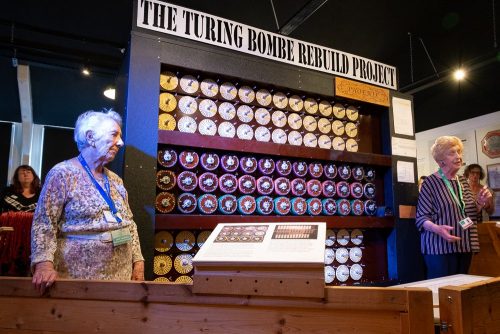On Saturday 23 June 2018, two veteran Bombe operators opened the new Bombe Gallery at The National Museum of Computing on Bletchley Park, just three months after the completion of a successful £50,000 Crowdfunder to finance the new display.

The Turing-Welchman Bombe automated the deciphering of Enigma-encrypted messages during the Second World War. As a tribute to the codebreakers, a team led by John Harper reconstructed the machine in 2007 and in April 2018, the Bombe was moved to The National Museum of Computing, close to the reconstruction of the Colossus computer that accelerated the breaking of Lorenz-encrypted messages of German High Command. Together these machines are credited with shortening the war by two years, saving countless lives.
At the opening of the new gallery TNMOC deputy chair Tim Reynolds said “We now have working reconstructions of two of the most important machines of the Second World War under one roof thanks to the generosity of our Crowdfunder donors. In their hey-day, these machines changed the world and today their significance is undiminished. Visiting student groups and the general public can watch in awe and be inspired by these historic working machines that paved the way to our digital world.”
Sworn to secrecy, the operators of the Bombes had little knowledge of the significance of their work until decades after the war.
At the gallery opening, WRNS (Women’s Royal Naval Service) and Bombe operator Ruth Bourne recalled: “We were told that we would be breaking German codes, but we never knew anything about it breaking Enigma! It was only years later that I read the books and discovered what I had been doing! During the war we were told never to tell anyone what we had seen or heard.”
Fellow WRNS and Bombe operator Jean Valentine said: “When I joined the Navy they asked about interests and hobbies. I told them I liked puzzles and crosswords and they said: we know where you will be going, but we don’t know what you will be doing there. They will tell you when you get there.”
At the opening of the gallery, each WRNS spoke of their vivid memories of the requirement for accuracy and concentration when using the Bombe, of the long shifts, repetitive work and the excitement of using the ‘red phone’ to tell army or navy personnel of a potentially significant message that they thought they could decrypt with the Bombe – though they never learned the contents of those messages.
At the opening, the WRNs were also able to meet and exchange notes for the first time with Margaret Bullen, who wired Colossus computers as they arrived on Bletchley Park.
For Bombe and Colossus Gallery opening hours, see here
About the Turing-Welchman Bombe reconstruction
The Turing-Welchman Bombe was the electro-mechanical device designed by Alan Turing and Gordon Welchman, based on a Polish concept, to automate the deciphering of Enigma-encrypted messages during the Second World War.
In the early 1990s John Harper, a retired engineer, was inspired to recruit a team to reconstruct a Bombe machine as a tribute to the wartime code-breakers at Bletchley Park. The reconstructed Bombe was completed and officially launched in 2007. The reconstruction replicates the standard British Bombe that contained 36 Enigma equivalents, each with three drums wired to produce the same enciphering effect as the Enigma cipher machine motors.
The reconstructed Bombe was moved to The National Museum of Computing at the end of April 2018 following an appeal for funds to the general public through a Crowdfunder. The new Gallery was rapidly equipped and opened officially on 23 June 2018.














